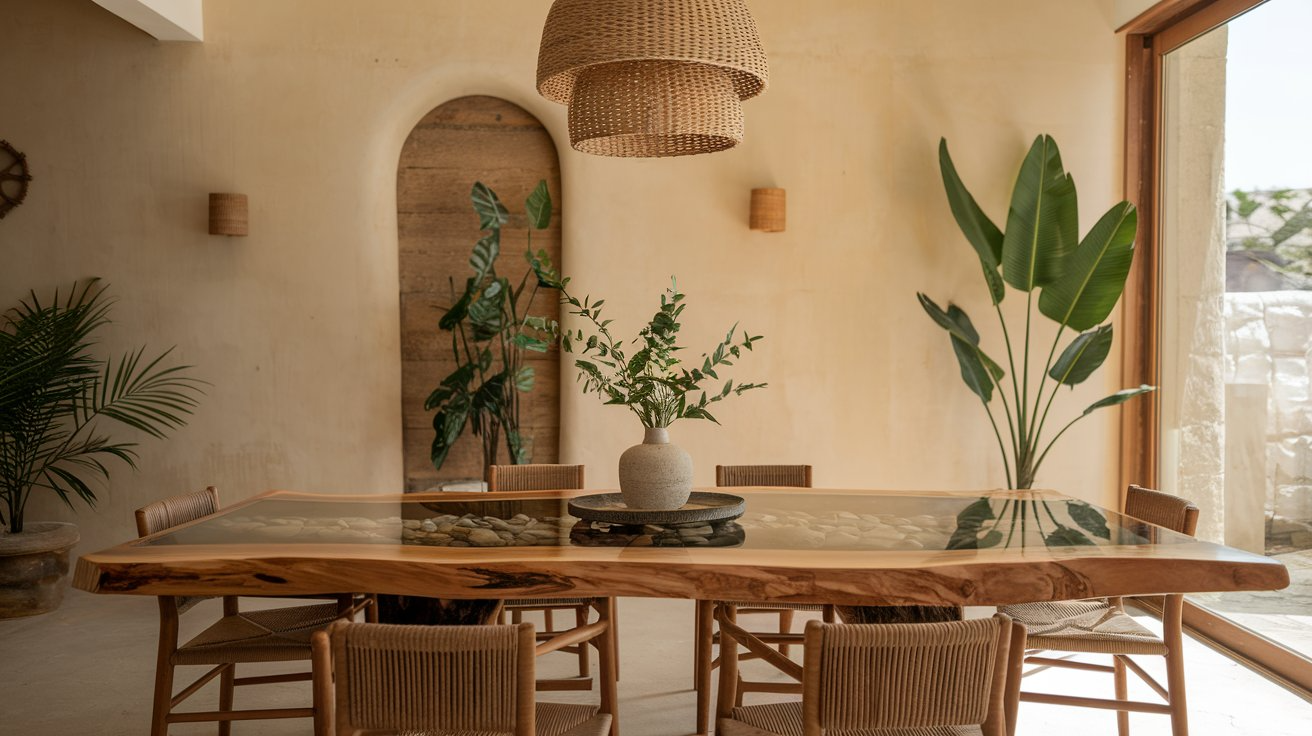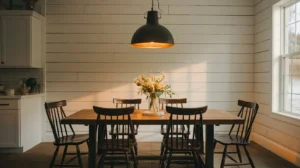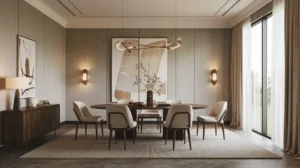This post may contain affiliate links. As an Amazon Associate, we earn a small commission at no extra cost to you.
Remember that revelation I had last year when I finally replaced my wobbly hand-me-down dining table? The one my college roommate left behind because it wasn’t worth moving? Yeah, I waited WAY too long for an upgrade. The moment I brought home my new solid wood table, my entire apartment suddenly felt like it belonged to an actual grown-up. Who knew a single piece of furniture could transform not just a room, but your whole vibe?
If you’re still gathering around a table that doesn’t speak to your soul (or worse, eating dinner on the couch), it’s time for a change. The modern organic dining table trend combines clean lines with natural materials to create pieces that feel both contemporary and timeless. These tables don’t just serve a function—they become the heart of your home, the spot where everyday meals become moments and gatherings become memories.
I’ve pulled together 20 Organic Dining Table Ideas that strike that perfect balance between cutting-edge design and natural warmth. Whether you’re working with a cozy breakfast nook or a grand dining room, there’s something here to transform your space into the gathering place you’ve always wanted.
1. Live-Edge Walnut Slab with Steel Legs
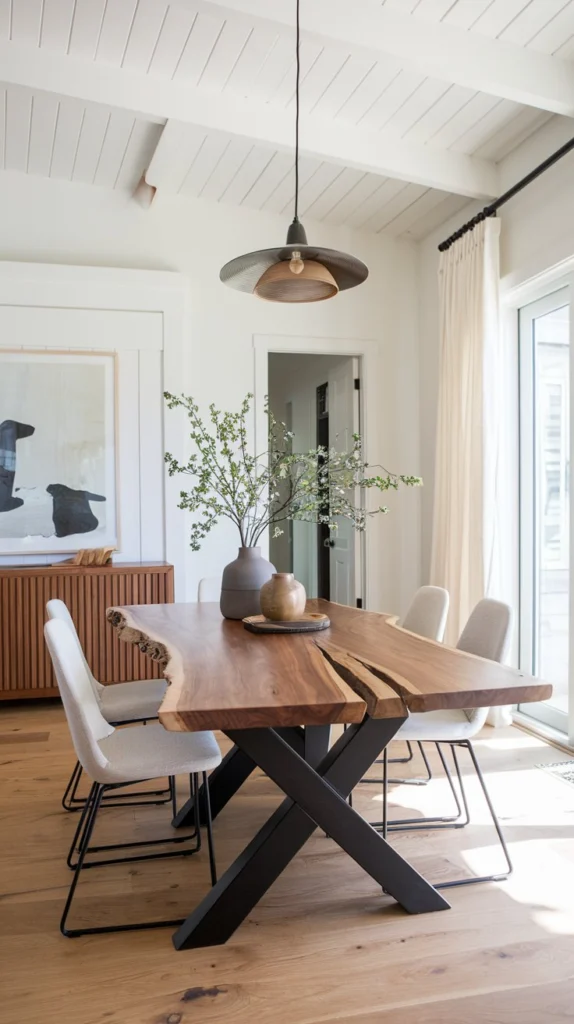
There’s something almost magical about a live-edge dining table. The natural, unfinished edge of the wood tells a story—celebrating the organic shape of the tree it came from rather than hiding it. Paired with minimalist steel hairpin or trapezoid legs, this combination creates the perfect tension between raw nature and precise human design.
Walnut is particularly stunning for this application, with its rich chocolate tones and complex grain patterns that become a natural piece of art in your dining space. Each slab is unique, meaning your table will be one-of-a-kind—a genuine conversation starter when you host guests.
These tables work beautifully in both small and large spaces. In compact apartments, a narrower slab creates an intimate dining experience, while larger homes can accommodate grand slabs that seat 8-10 people comfortably. The beauty of custom live-edge pieces is that they can be sized to your specific needs.
Recommended selections available on Amazon:
2. Round Bleached Maple Table
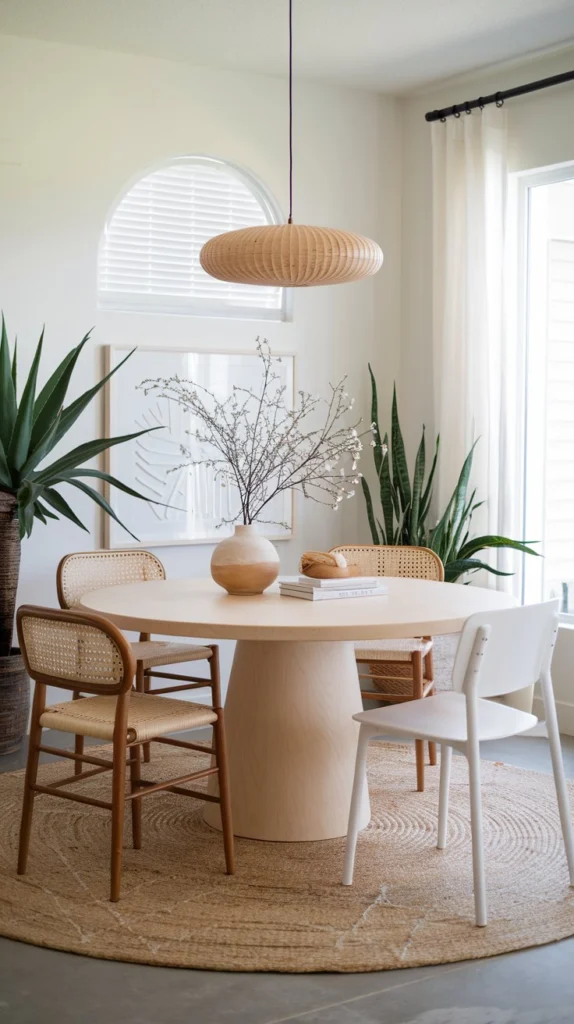
Round dining tables naturally encourage conversation, with no one stuck at the “head” of the table and everyone able to see each other easily. When crafted from bleached maple, these tables take on an almost ethereal quality—light, bright, and wonderfully versatile.
The bleaching process strips away the yellow tones typically found in maple, leaving behind a beautiful pale wood that feels thoroughly modern yet organic. This lighter finish works particularly well in smaller spaces, visually taking up less room than darker woods while reflecting light beautifully.
Pair your round bleached maple table with a mixture of seating—perhaps two small benches and two chairs—to create a collected feel that avoids the matchy-matchy dining sets of previous generations. This approach feels more personal and curated, like your space evolved naturally over time.
Recommended selections available on Amazon:
- 【DIMENSIONS】47″L x 47″W x 30″H; Table Only, Chair not included. Concrete dining table will ship to you in 2 boxes (table…
- 【HIGHLY DURABLE AND HEAT RESISTANT】: Cement is a very strong material with excellent compressive strength and abrasion r…
- 【LOW MAINTENANCE REQUIREMENTS】: the surface of the cement dining table has been treated to provide some stain and water …
3. Reclaimed Barn Wood with Glass Insert
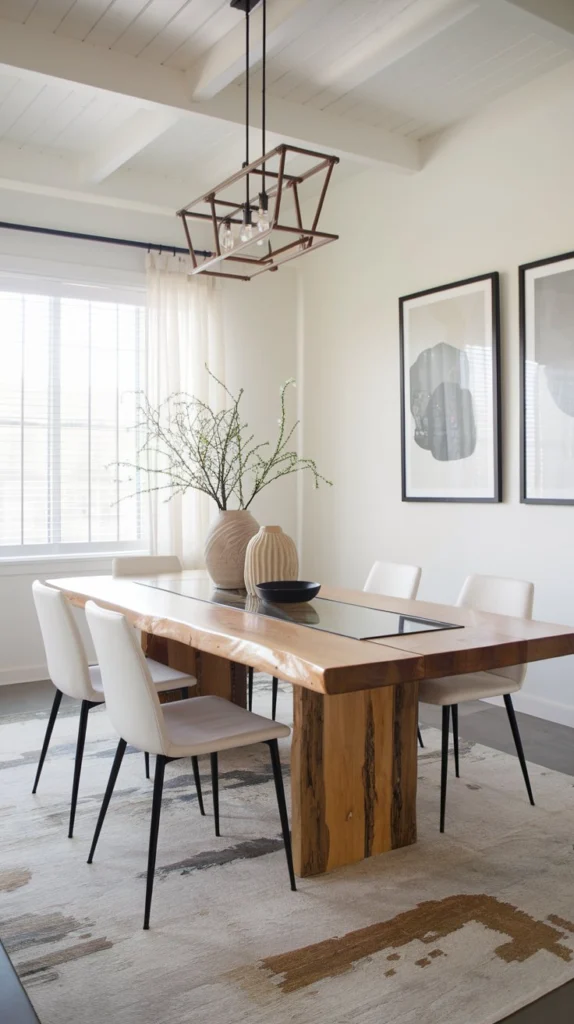
Salvaged barn wood carries stories within its weathered surface—a history of use that new materials simply can’t replicate. When transformed into a dining table with a glass insert running down the center, the result is a beautiful juxtaposition of rustic and refined.
The glass center creates a stunning visual display opportunity—change out seasonal elements beneath it for ever-evolving tablescapes. In spring, perhaps dried flowers or moss; in winter, pine branches or LED string lights. This interactive element turns your table into a dynamic part of your home’s décor.
Beyond aesthetics, this design offers practical benefits too. The glass creates a smooth surface for placing glasses or plates, while the textured wood frames the dining experience without interfering with function. It’s the perfect compromise for those who love character but also appreciate practicality.
Recommended selections available on Amazon:
- Please Read the Description Properly Before Purchasing
- Customs Duties, VAT, and any additional tax are paid by the customers only.
- If any sales tax is charged to you while making the purchase it is done by Amazon, not by us
4. Marble and Ash Combination Table
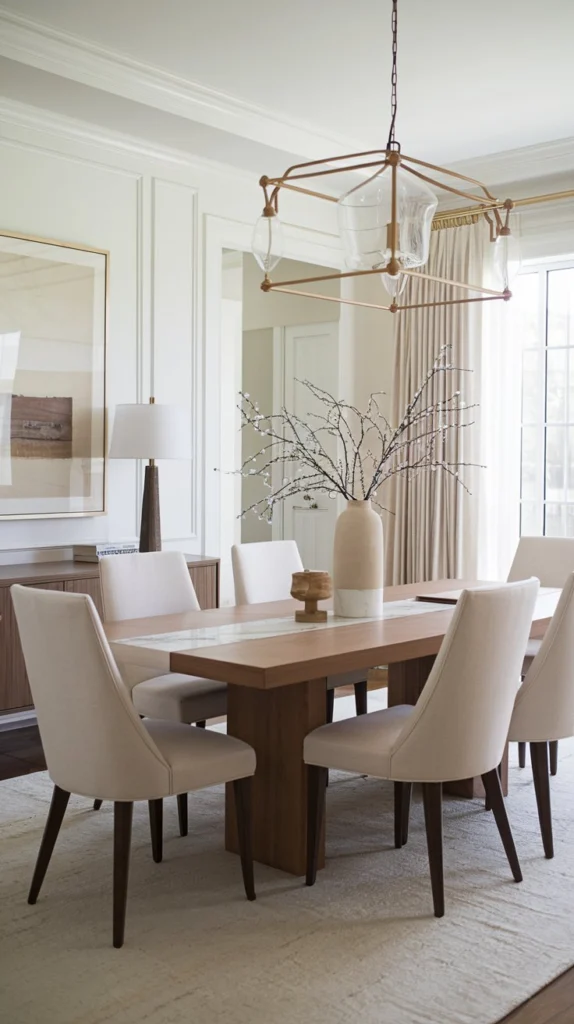
For those who appreciate a more elevated dining experience, the combination of marble and ash creates a sophisticated yet organic table that feels both luxurious and grounded. The cool, veined surface of white or gray marble paired with the warm tones of ash wood strikes a beautiful balance.
Consider a design where the marble forms an inset rectangle in the wooden table, creating a natural serving area that’s both practical and visually striking. This designated section is perfect for placing hot dishes or serving platters, protected by the heat-resistant marble.
The beauty of this pairing lies in how the materials complement each other—the organic veining of the marble echoes the natural grain patterns of the wood, creating a harmonious visual conversation between these two distinct natural materials.
Recommended selections available on Amazon:
- 【Luxurious Marble-Look Tabletop】The table features a stunning marble-effect surface, offering the elegance of natural st…
- 【Ample Seating Capacity】This table comfortably accommodates 6 to 8 people, making it suitable for both everyday use and …
- 【Versatile Rectangular Design】The spacious rectangular shape makes this table ideal for various settings, from intimate …
5. Floating Reclaimed Teak Slab

There’s something almost sculptural about a thick teak slab that appears to float in space. Mounted on a nearly invisible steel base, these tables create a striking visual impact—the rich, honeyed wood becoming the undisputed star of your dining area.
Reclaimed teak is particularly special, having often lived a previous life as part of boats, buildings, or other structures. This history gives the wood a depth of character and patina that new teak simply can’t match, with each scratch and imperfection telling part of its story.
What makes this design distinctly modern is the contrast between the substantial wood and the minimalist base. The heavy visual weight of the thick teak seems to defy gravity, creating a tension that draws the eye and elevates the entire room.
Recommended selections available on Amazon:
- Size:60w x 30d x 30h” inches
- Versatile Design: Suitable for dining rooms, kitchens, or casual seating areas.
- Ample Seating: Accommodates up to 4-6 people comfortably.
6. Concrete and Oak Hybrid
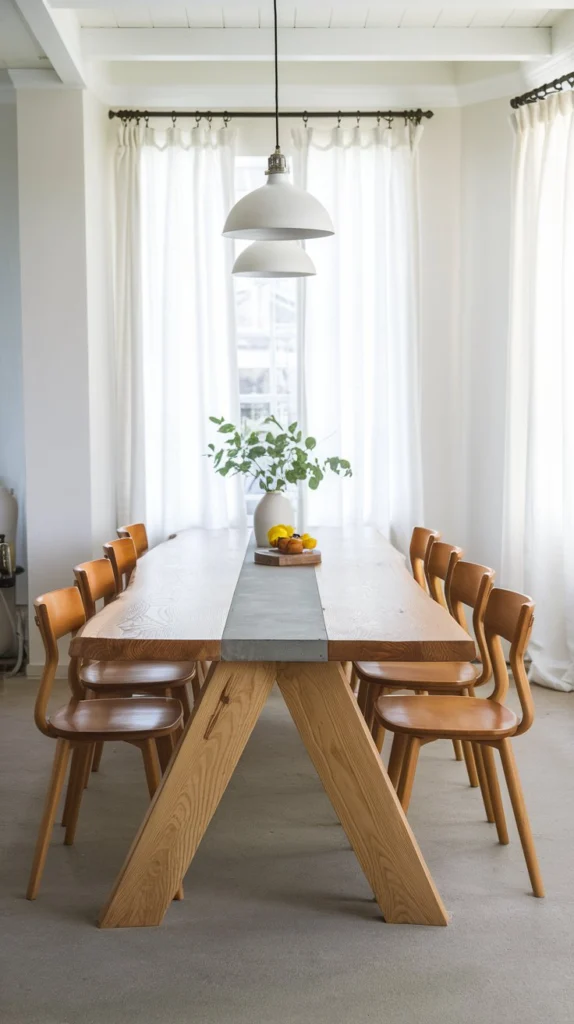
Combining the industrial coolness of concrete with the natural warmth of oak creates a dining table with perfect balance—neither too cold nor too rustic. This material marriage speaks to the contemporary organic aesthetic that’s defining modern interiors.
Consider a design where a cast concrete strip runs down the center of an oak table, or where concrete forms the base while oak creates the top. These unexpected combinations feel fresh and architectural, like something you’d find in a design magazine feature.
Beyond aesthetics, this pairing offers practical benefits. The concrete component adds substantial weight and stability, while the wood brings warmth and tactile comfort where your arms rest. It’s a thoughtful marriage of materials that considers both form and function.
Recommended selections available on Amazon:
7. Sculptural Single-Piece Base Table

Move beyond the expected four legs with a dining table featuring a sculptural, monolithic base. These statement pieces transform the humble dining table into a genuine work of art, with the base becoming as important as the tabletop itself.
Look for designs where a single piece of wood has been carved into an organic, flowing form that supports a simple round or oval top. The contrast between the elaborate base and the clean-lined top creates a visual tension that feels thoroughly modern yet connected to traditional woodworking craftsmanship.
These tables command attention in a space, making them perfect for minimalist dining rooms where the table can be the undisputed focal point. Keep surrounding elements simple—let the sculptural quality of the table be the room’s statement piece.
Recommended selections available on Amazon:
- Solid Wood
- Premium material: this dining table ensures that each piece of wood displays its natural grain and color. This table not…
- Spacious design: This 47.2-inch round dining table comfortably seats 4 to 6 people for everyday meals or special occasio…
8. Split-Level Dining Surface
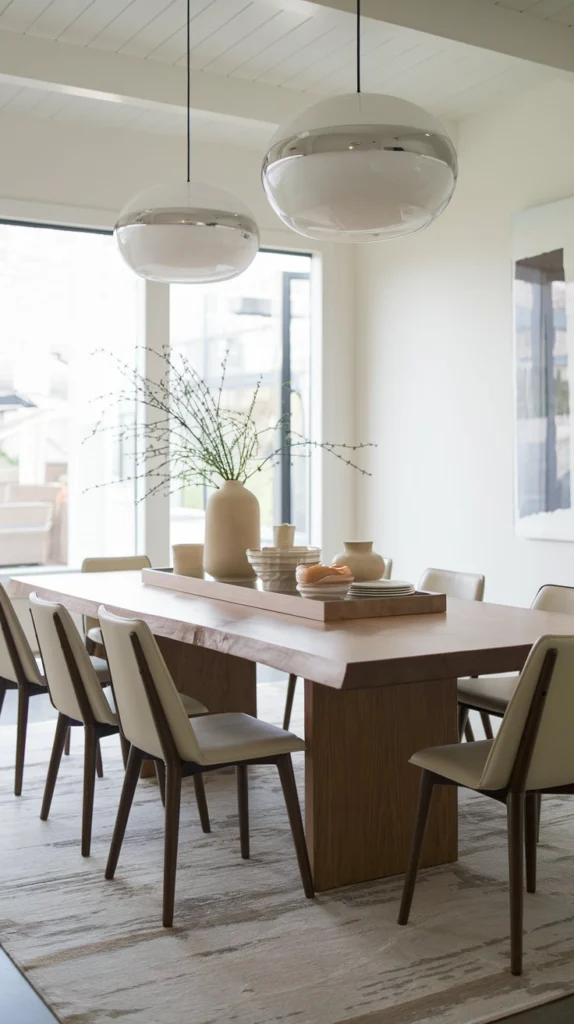
For those who entertain frequently, a split-level dining table offers both visual interest and practical functionality. These innovative designs feature a main dining surface with a slightly raised or lowered section, creating distinct zones within a single table.
This design brilliantly solves the serving dilemma—the raised section can hold shared dishes, condiments, or decorative elements, keeping them accessible but separate from the main dining space. It’s like having a built-in sideboard incorporated into your table.
Look for designs where the level change is subtle—just a few inches—to maintain conversation flow while still creating that functional distinction. This thoughtful approach to dining furniture addresses how people actually use their tables, not just how they look.
Recommended selections available on Amazon:
- This modern votive set showcases a sleek mango wood tray with 2 stoneware planters and 3 vases
- Multicolor votive set with mango wood tray, 3 stoneware vases, and 2 planters in a naturally variating reactive glaze
- Curate a space that reflects your unique sense of style with intentionally designed home décor
9. Book-Matched Wood Slab
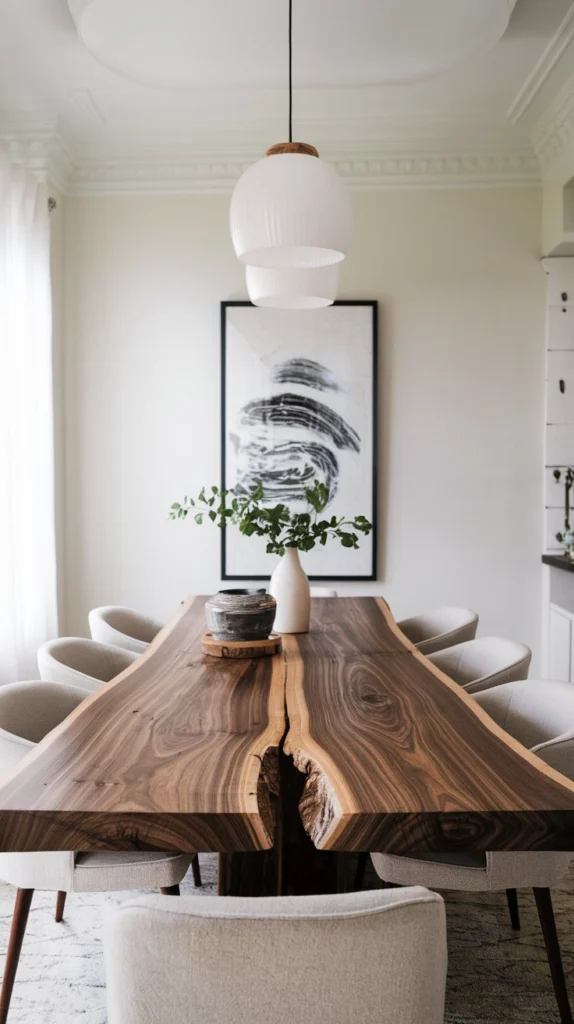
Book-matching—where wood is cut and opened like a book to create mirror-image grain patterns—transforms a simple wood slab into something truly spectacular. When this technique is applied to a dining table, the result is a symmetrical pattern that draws the eye and showcases the wood’s natural beauty.
This technique works particularly well with woods that have dramatic grain patterns, like walnut, maple burl, or olive wood. The symmetry created by book-matching gives the organic, free-flowing wood grain a sense of intentionality and structure that feels contemporary.
While these tables make a statement on their own, their natural patterning means they play well with other textured elements in your dining space. Consider pairing with textured ceramic dishware, linen napkins, or raw-edge placemats to create a richly layered organic dining experience.
Recommended selections available on Amazon:
- WHY WE : With the help of 100+ Experts and skilled men , We believe that we are creating an art and memories , so we do …
- Our Process : Once order has been placed we do send the wood placements to you to check and keep you posted every 4 days…
- Customization: We accept each and every type of resin Table customization’s in terms of Sizes , shapes or colors . Each …
10. Asymmetrical Organic Shape
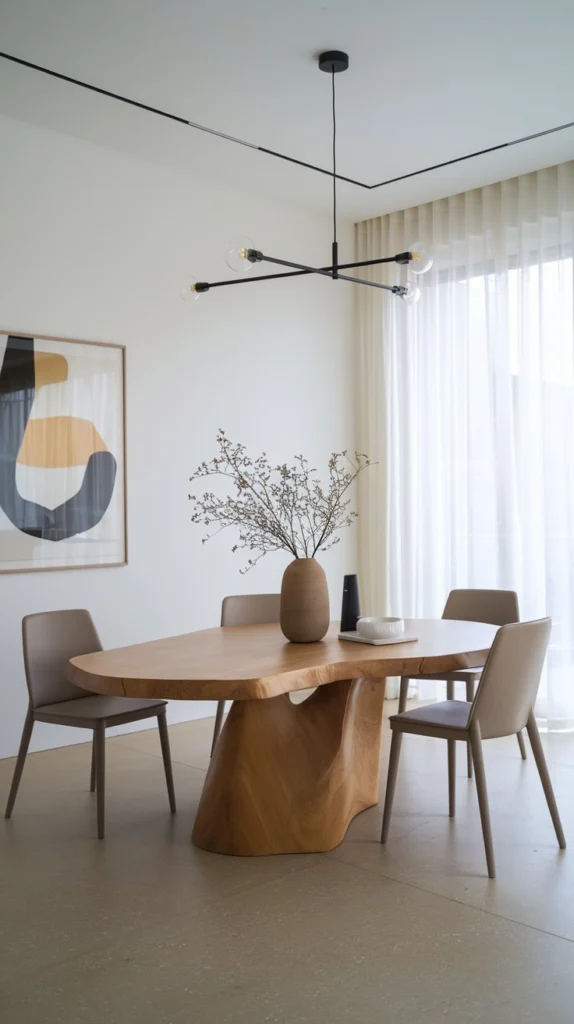
Break away from the predictable rectangle with a dining table featuring an organic, asymmetrical form. These free-form tables bring a sense of movement and spontaneity to dining spaces, their curved edges mimicking shapes found in nature rather than adhering to rigid geometry.
Despite their unconventional outlines, these tables can actually maximize seating in challenging spaces. The varied edge means some areas can extend deeper into the room where space allows, while others can curve inward where passage is needed—perfect for awkward room layouts or open concept spaces.
For balance, pair these dynamic tables with simple, clean-lined chairs that don’t compete with the table’s organic shape. The juxtaposition of the fluid table form with more structured seating creates a harmonious tension that feels deliberately designed rather than haphazard.
Recommended selections available on Amazon:
11. Embedded River Rock Table
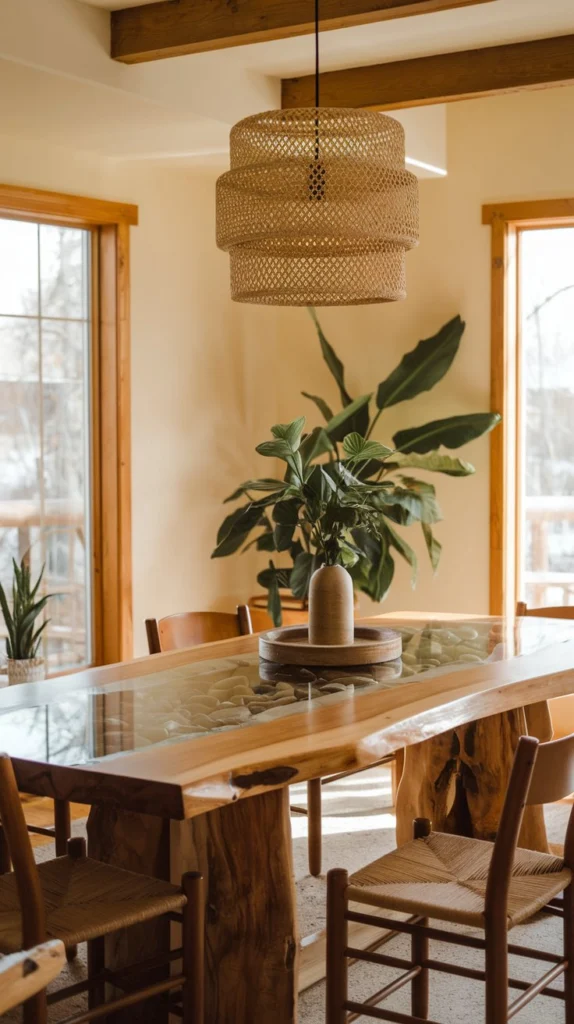
Taking inspiration from Japanese river tables but with a more subtle approach, tables with embedded river rocks bring natural elements directly into your dining surface. Rather than the blue resin “river” that became trendy, this version features small sections where actual river stones are embedded under a flush glass cover.
These stone sections might run along the edge of the table or appear as small “pools” within the wood surface. The smooth, varied stones create visual interest and tactile curiosity—a natural art installation integrated into your dining experience.
The beauty of this design lies in its restraint. By limiting the stone elements to small sections, the table maintains its functionality while offering unexpected moments of natural beauty. It’s a conversation starter that doesn’t sacrifice practicality.
Recommended selections available on Amazon:
12. Charred Wood Shou Sugi Ban Table
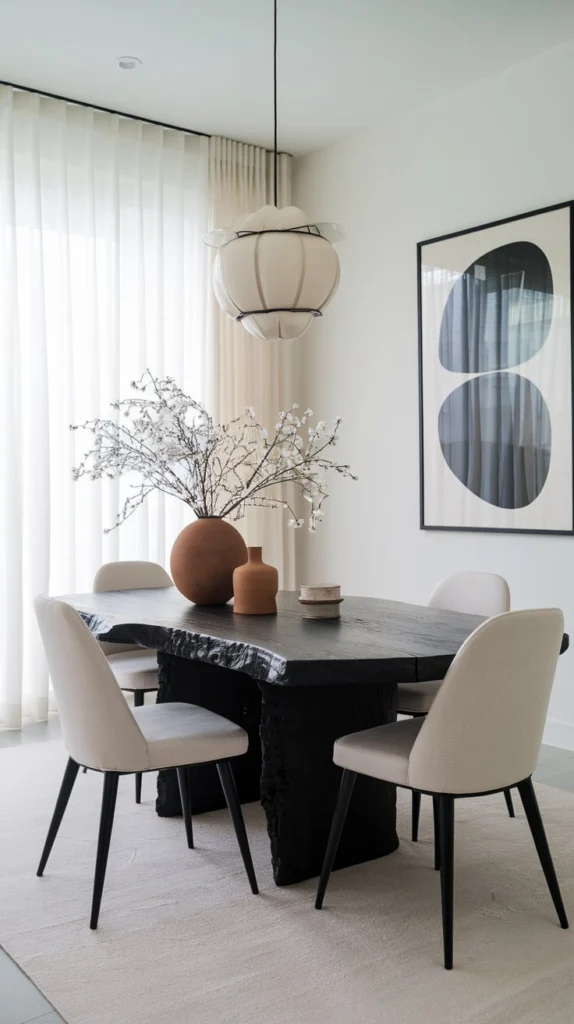
Shou Sugi Ban, the Japanese technique of charring wood to preserve it, creates dining tables with extraordinary depth and character. The controlled burning process blackens the surface while highlighting the wood’s grain pattern in raised relief, creating a tactile topography that begs to be touched.
Beyond its striking appearance, this ancient technique actually makes the wood more durable—naturally water-resistant and less prone to insect damage. It’s a rare instance where the most visually interesting option is also the most practical.
The deep black surface creates a dramatic foundation for colorful meals and tableware. White plates, bright vegetables, and vibrant table linens pop dramatically against the charred surface, making everyday dining feel more intentional and visually striking.
Recommended selections available on Amazon:
13. Mixed Wood Species Table

Like a well-composed piece of music, a table that thoughtfully combines different wood species creates harmony through contrast. Consider designs where strips of contrasting woods—perhaps walnut, maple, and cherry—are joined to create a striped effect, or where the table edge features a border of a different species than the center.
What makes this approach feel modern rather than busy is restraint in the overall design. Let the wood variety be the only decorative element, keeping the form of the table clean and simple. The natural differences in grain and color provide all the visual interest needed.
This multi-species approach also allows you to tie together different wood tones that might already exist in your space. If you have oak flooring but walnut cabinets, for example, a table incorporating both woods creates a bridge between these elements.
Recommended selections available on Amazon:
14. Textured Edge Detail
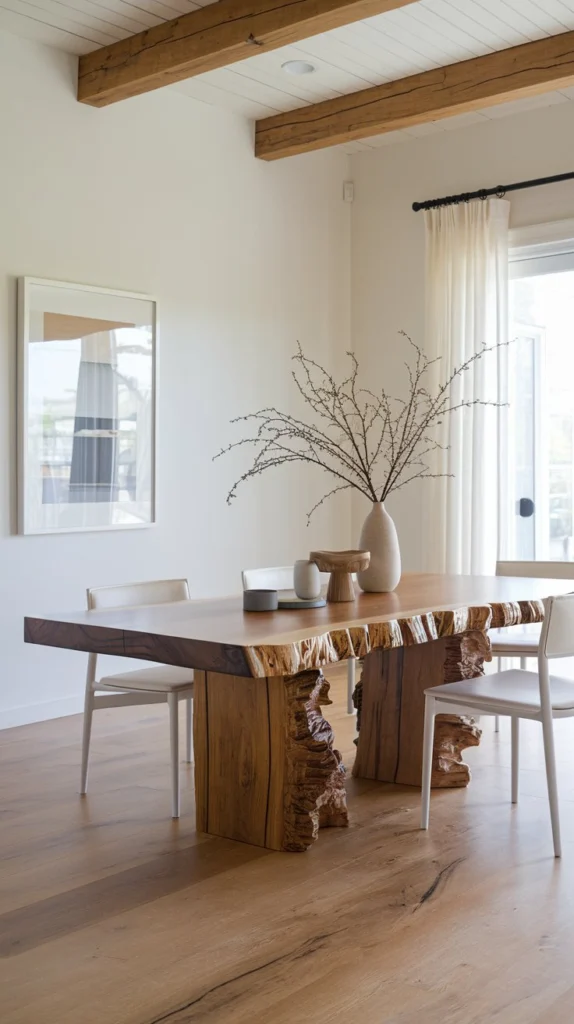
Sometimes the most compelling design statements come from focusing attention on what’s typically overlooked. A dining table with an intentionally textured or carved edge transforms the perimeter—usually just a plain surface—into a feature deserving of attention.
Look for designs where the table edge has been hand-chiseled to create a subtle rippled effect, wire-brushed to emphasize the grain pattern, or even carved with a repeating organic motif. These tactile details invite interaction—your hands naturally want to explore the textured surface.
While the textured edge creates visual interest, keeping the tabletop smooth ensures the table remains fully functional for dining. This thoughtful balance between design statement and practicality exemplifies the best of modern organic furniture design.
Recommended selections available on Amazon:
- ✦ The modern solid wood dining table offers a elegance to your home. Crafted of durable pine, the table will bring you a…
- ✦ Dimensions: Dining Table: 70.9″L x 31.5″W x 29.5″H. (Various sizes available)
- ✦ Made entirely of solid wood to create a wide table top, stable and thick, with clear texture and not easy to crack. Ou…
15. Integrated Planter Section

Bring literal life to your dining table with a design that incorporates a built-in planter section. These innovative tables feature a recessed trough running down the center, lined to contain soil and moisture, where you can grow herbs, succulents, or small ornamental plants.
Beyond the obvious visual appeal, this design offers practical benefits for those who enjoy cooking and entertaining. Imagine snipping fresh herbs directly from your table to finish a dish, or creating a constantly evolving centerpiece that changes with the seasons.
For those concerned about maintenance, this concept works beautifully with low-care plants like succulents or preserved moss. The greenery adds a living element to your dining experience without requiring constant attention.
Recommended selections available on Amazon:
- PRODUCT DETAILS: Gardener’s Supply Company Exclusive Rectangular Copper-Coated Tray is perfect to showcase your favorite…
- BEST USE FOR: Create a unique dish garden with some of your favorite indoor or outdoor plants. Plant your succulents, ad…
- HIGH QUALITY CRAFTSMANSHIP: Made from copper-coated stainless streel with padded feet to prevent scratching surfaces. Se…
16. Geometric Inlay Pattern
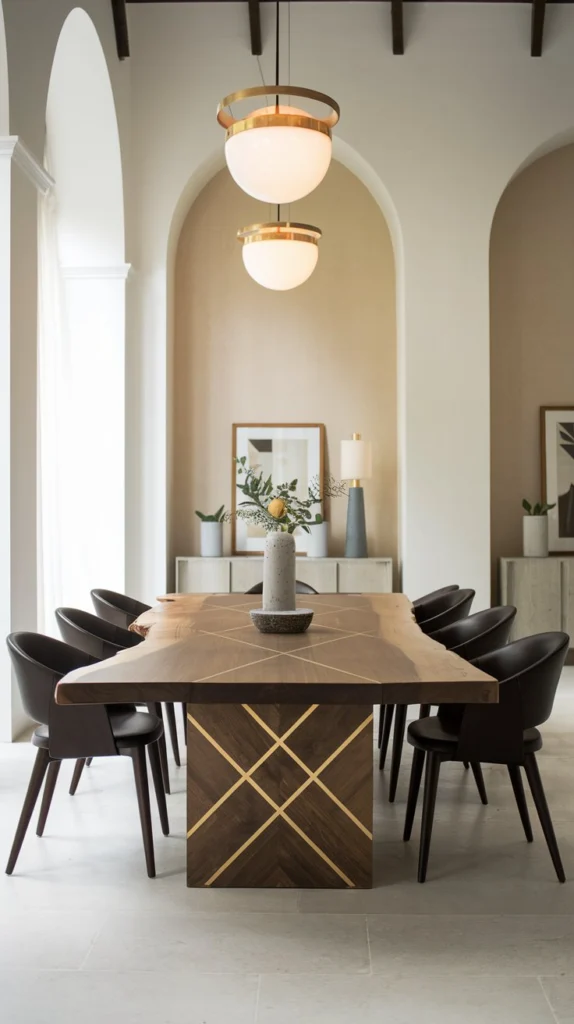
For those drawn to more patterned expressions of modern organic style, consider a wooden table featuring geometric inlays in contrasting materials. Think brass lines creating a simple geometric pattern across the wood surface, or triangular mother-of-pearl insets adding subtle shimmer.
The key to keeping this look contemporary rather than busy is mathematical precision and restraint. Clean lines, perfect symmetry, and limited material palette ensure the inlay reads as intentional modern design rather than elaborate decoration.
These tables offer the warmth and organic quality of wood while incorporating the structure and precision that defines contemporary design. The result feels curated and intentional—a piece that will remain timelessly elegant rather than trending momentarily.
Recommended selections available on Amazon:
17. Cantilevered Extension Table

Embrace both form and function with a dining table featuring a cantilevered extension leaf. Unlike traditional extension tables with visible seams and mechanical parts, these modern interpretations appear as solid sculptural pieces that can transform when needed.
The cantilevered design allows a section of the table to swing out or slide smoothly from underneath, nearly doubling your dining surface for larger gatherings. When not extended, the table appears as a cohesive design statement with clean lines and no visible hardware.
This solution is particularly valuable for those who entertain occasionally but don’t want their everyday dining experience dominated by a table sized for maximum capacity. It’s thoughtful, adaptable design that responds to the realities of contemporary living.
Recommended selections available on Amazon:
18. Nested Height Variations
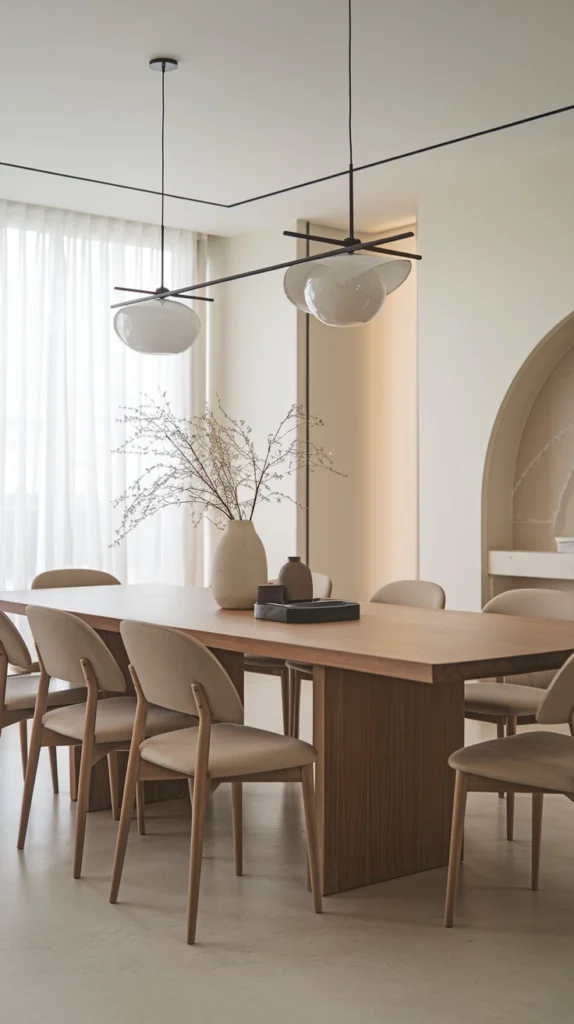
Challenge the conventional single-plane dining surface with a table featuring subtle height variations. These innovative designs incorporate sections at slightly different elevations—perhaps a central plateau for serving dishes or lower perimeter sections that create a subtle boundary.
The varied topography creates natural zones for different dining elements—elevated sections keep shared dishes prominent and accessible, while lower areas define individual place settings. This thoughtful approach to dining furniture considers the social experience of sharing a meal.
Despite the height changes, these tables maintain a cohesive visual identity through consistent materials and clean transitions between levels. The result feels intentional and sculptural rather than random or distracting.
Recommended selections available on Amazon:
19. Floating Panel Design

Bringing architectural principles to furniture, floating panel dining tables create visual lightness despite their substantial size. These designs feature a top surface that appears to float above the base, with a visible gap creating a shadow line that adds dimensional interest.
This floating effect can be achieved through clever engineering—perhaps a recessed central support or strategically placed legs that sit back from the edge. The visual trick makes even substantial tables appear less imposing in your space.
Beyond aesthetics, this design often incorporates practical benefits. The separation between top and base can create convenient small storage spots for table linens or place mats, seamlessly integrating function into the design statement.
Recommended selections available on Amazon:
20. Raw Edge with Polished Top
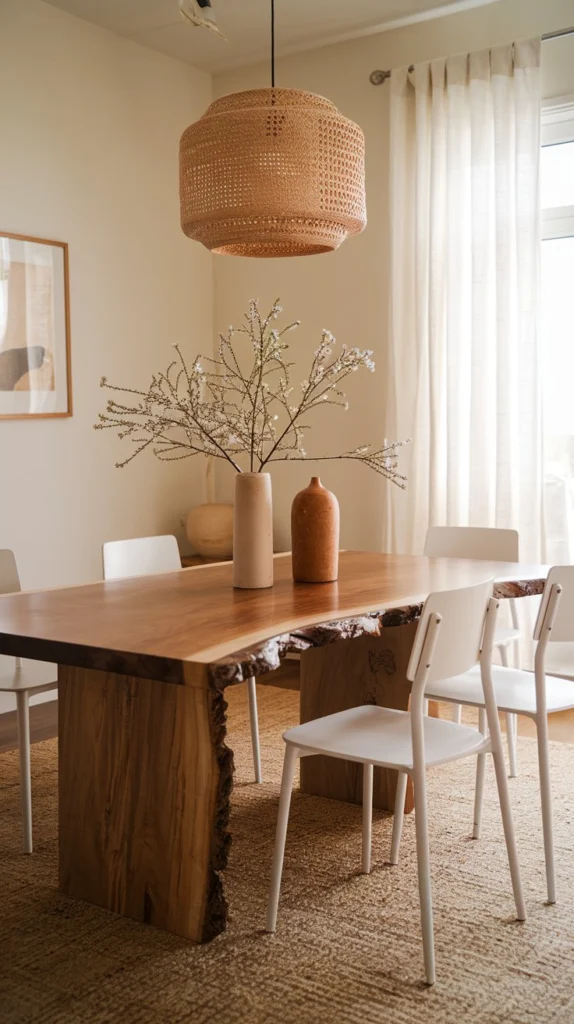
Embrace the beautiful tension between refined and raw with a table that features polished, perfectly flat dining surface surrounded by an intentionally rough, natural edge. This combination honors the organic origin of the wood while ensuring practical functionality.
Unlike fully live-edge tables, this approach keeps the natural character limited to the perimeter, where it won’t interfere with plate placement or glass stability. The result feels both organic and precisely crafted—the perfect embodiment of the modern organic aesthetic.
This design works with nearly any wood species, but those with dramatic grain patterns or interesting coloration particularly shine. The polished top brings out the wood’s natural beauty, while the raw edge reminds us of its origin as a living tree.
Recommended selections available on Amazon:
Bringing It All Together
The modern organic dining table does more than just provide a surface for meals—it creates a gathering point that grounds your home in both natural materials and contemporary design principles. Whether you’re drawn to the dramatic statement of a live-edge slab or the subtle sophistication of mixed materials, these tables have staying power beyond fleeting trends.
Remember that the best dining spaces feel collected rather than purchased as a matching set. Consider pairing your statement table with simpler chairs that don’t compete visually, or introducing organic elements through tableware and textiles if your table design is more restrained.
I’d love to see how you incorporate these ideas into your own dining space! And if you found these ideas helpful, please share this post with fellow design enthusiasts looking for inspiration.
Ready for more inspiration? Check out these 20 Scandinavian Dining Room Ideas to kickstart your next makeover.
Your perfect gathering spot is waiting to be created!

